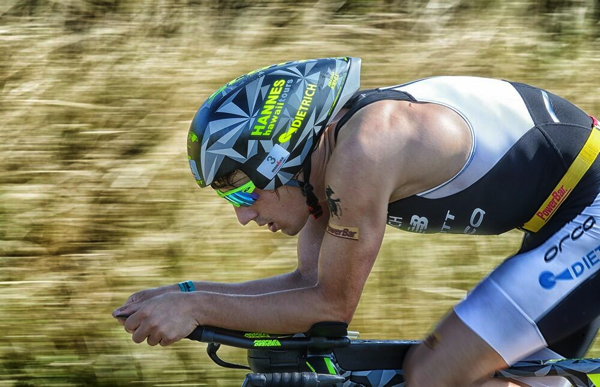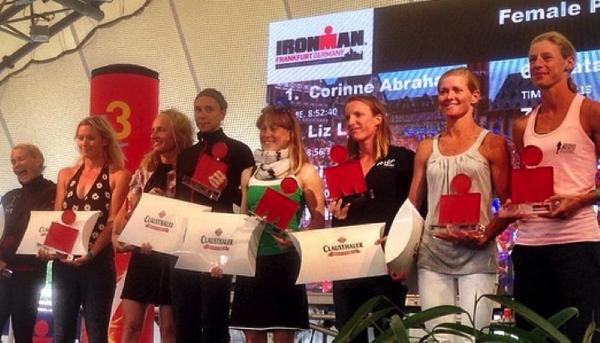Last Sunday, WTC announced a number of changes to the KPR. Rather than go through the changes (other sites have already done a great job on this, for example Triathlete or Witsup), I want to focus a bit more on some of the details and consequences of this announcement.
Fewer Pro IM races in North America
One area of the announcement that has created quite a stir was that half of the North American Ironman races will no longer have a Pro prize purse and will no longer offer KPR points. After the changes are implemented, only the following races will remain:
- IM Chattanooga (September)
- IM Arizona (November)
- IM Cozumel (December)
- IM Texas (May, Regional Championship)
- IM Coeur d’Alene (June)
- IM Canada/Whistler (July)
- IM Mont Tremblant (August)
This will mean that there will be only seven professional Ironman races in North America, after 14 in 2014. This is reducing the number of Ironman races to 50%.
There hasn’t been an official explanation why these races were chosen over the other races.
It is difficult to go from the final decisions back to the guidelines that have played a role. In the absence of an official explanation why these races were chosen over the other races, here are my guesses:
- proper arrangement of races on the calendar (e.g. no overlap of races)
- cutting Pro races with a lower prize purse
- existing contracts with the towns hosting the events
What about other Regions?
At first, the changes were widely assumed to be a re-focusing of WTC away from the North American market towards markets where they face stronger competition by Challenge (i.e. Europe and Australia). However, on the 2015 events page there is the following statement:
“2015 IRONMAN Pro Event Schedule will be updated promptly as events are confirmed and finalized for Europe and Asia Pacific region.”
I have asked WTC about changes in other regions and received the following statement:
The most significant changes will be in the America’s. Some changes and refocusing of money and points strategically in EMEA region. Status quo in AP region with an eye to continue the process of refining the schedule. [..] The politics of removing the Pro component requires more consideration and negotiation.
This indicates that we can expect some changes at least in Europe as well, but that there will be some time before final announcements.
What might happen in Europe?
The changes in Europe can’t really be determined without any insight into the discussion with the regional WTC organizations and companies. However, I’m pretty sure that there will be some changes. At this point, I think that there is only one race that we can be sure of: the Regional Championship race in Frankfurt.
Here’s a discussion of the pros and cons for the other European races:
- IM Wales and IM Mallorca (September) – both races with a small prize purse, but in an interesting time slot
- IM Barcelona (October) – new race with a large purse, but a potential overlap with Kona
- IM Lanzarote (May) – one of the few remaining licensed races, there have been rumors for a long time that it might be shut down, small prize purse, but in an interesting time slot
- IM France and IM Austria (early July) – overlapping races, also very close to Frankfurt, but with a large prize purse
- IM UK (mid July) – small prize purse, but I find it unlikely that WTC would cut both of the Great Britain races
- IM Switzerland (late July) – small prize purse, but in an interesting time slot
- IM Sweden and IM Copenhagen (August) – overlapping races, both with a good prize purse
Here’s my best guess at what the final Pro race schedule in Europe would look like:
- September/October: IM Wales, IM Mallorca or IM Barcelona
- May/June: IM Lanzarote or a re-scheduled IM France
- early July: IM Frankfurt (Regional Championship)
- late July: IM Austria (re-scheduled) or IM Switzerland
- August: IM Sweden or IM Copenhagen
Again, local considerations and existing contracts may change this speculative calendar. However, I think it’s likely that we will end up with a slightly lower number of Pro races in Europe as in North America. My speculation has five races, and I find that a reasonable guess in comparison to the seven races in North America. (There might be one or two more races, but I don’t see a clear favorites for these extra races or time slots.)
So .. what’s the total number of races?
We can be reasonably safe to assume that there won’t see any changes in Africa (only IM South Africa) or South America which only has two races (the established May race in Florianopolis which will become a Regional Championship and the new Fortalezza race is November).
There is currently one races in Asia (Japan), one race in New Zealand and four races in Australia. Based on the above statement („Status Quo“), there won’t be any changes. However, there will be two new races in Asia (Malaysia starting 2014, Taiwan starting 2015), and in exchange there might be one Australian race no longer offering a Pro purse.
I’m looking forward to formal announcements by WTC that will clarify their intentions for regions outside of North America.
To sum up my guesses, here is a look at the number of races in each of the regions after 2015:
- 7 races in North America
- 2 races in South America
- 1 race in Africa
- 3 races in Asia
- 4-5 races in Australia/New Zealand
- 5-6 races in Europe
All in all, my guesses point to 22 to 24 races (plus Kona). This is a bit more than half of the total number of Ironman races that will be on the calendar. If no races outside of North America lose their Pro status, there will be 29 Ironman Pro races (plus Kona) – but of course by 2015 there may be other new races and changed to the calendar.
What will happen to late 2014 races?
One of the stranger things with the WTC announcement is that the 2014 races will not change. For example, Ironman Florida 2014 will still offer prize money, KPR points and a chance to validate Kona slots, so the qualifying period for Kona 2015 (starting in September 2014) will be a mix of the „full“ and the „reduced“ race calendar. In fact, the North American races no longer offering a Pro purse (Los Cabos, Lake Placid, Boulder, Louisville) might be canceled out by new races (Mallorca, Malaysia, Chattanooga, Barcelona, Taiwan).
This also means that the 2015 qualifying season will be even more „front-loaded“ (points in the „old year“ around Kona) – while it is the stated intention of the new race calendar to move points into the “main season” (April to July). This might need some adjustments – or WTC views this as „transitional pain“ of moving from the old to the new system.
In all cases, the full move to the new schedule will take two years and we will see two major changes in the Pro race calendar (and the corresponding changes in the KPR cutoffs) in the next two years. Lots of uncertainties for the Pros that want to make it to Kona …
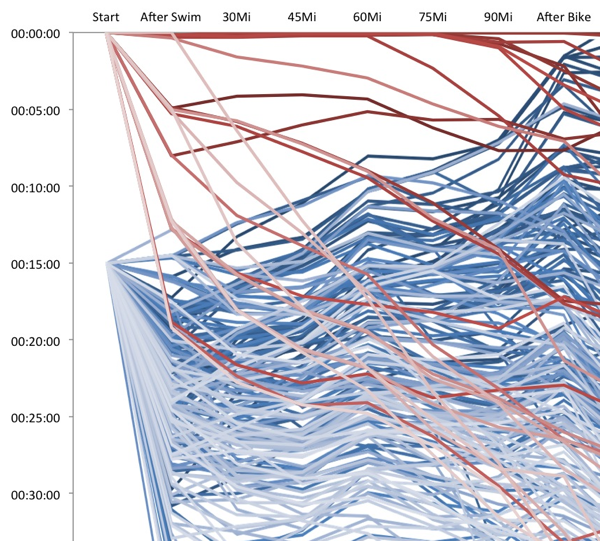
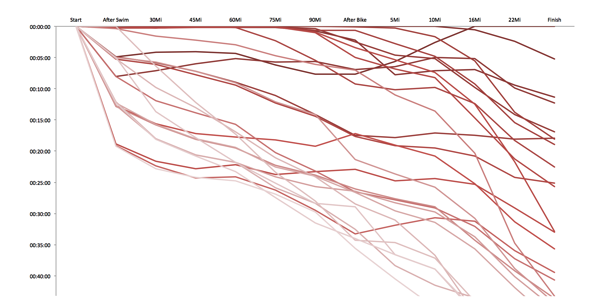 The horizontal x-axis shows different points during the race, such as the start, after the swim, and various points on the bike and the run up to the finish. The vertical axis shows how far back each athlete is from the front of the women’s race. So for example, you can see all the athletes start together, then some of them being as far back as 20 minutes after the swim, and – towards the end – the final change in the lead around 15mi on the run. Each of the red lines represents one women’s race. Now let’s add the Age Group Men (blue lines) to this graph:
The horizontal x-axis shows different points during the race, such as the start, after the swim, and various points on the bike and the run up to the finish. The vertical axis shows how far back each athlete is from the front of the women’s race. So for example, you can see all the athletes start together, then some of them being as far back as 20 minutes after the swim, and – towards the end – the final change in the lead around 15mi on the run. Each of the red lines represents one women’s race. Now let’s add the Age Group Men (blue lines) to this graph: 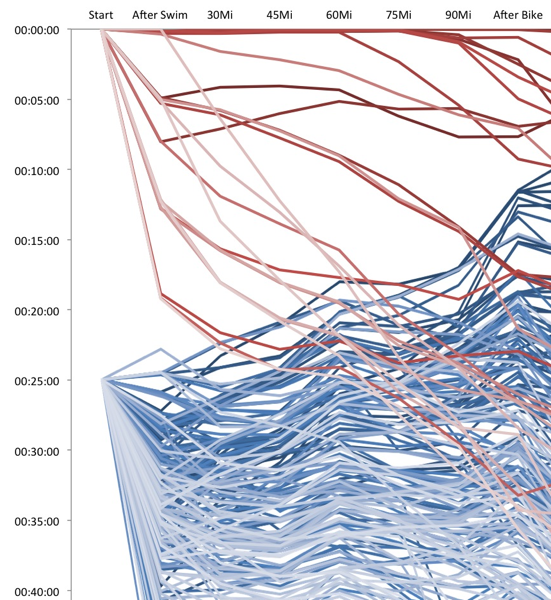 You can see the men starting 25 minutes behind the women, and the fastest of them slowly making their way through the slower Pro women. Here are some more facts that you can’t easily discern from the graph:
You can see the men starting 25 minutes behind the women, and the fastest of them slowly making their way through the slower Pro women. Here are some more facts that you can’t easily discern from the graph: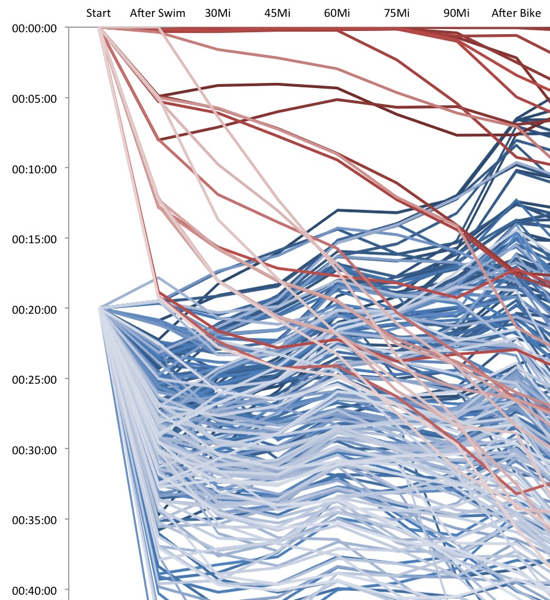 Here are the corresponding facts to the 25 minute section:
Here are the corresponding facts to the 25 minute section: